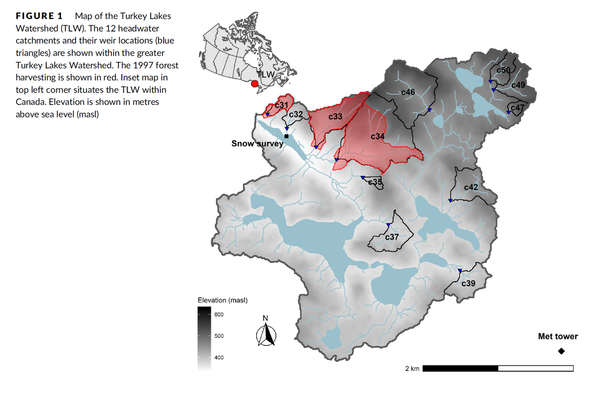|
Leach JA, Buttle JM, Webster KL, Hazlett PW, Jeffries DS. 2020. Travel times for snowmelt-dominated headwater catchments: Influences of wetlands and forest harvesting, and linkages to stream water quality. Hydrological Processes. Jason Leach and Kara Webster are from Natural Resources Canada, Canadian Forest Service and Jim Buttle is from Trent University. They work together in the Boreal Shield platform of the forWater Network. Summary The time required for water to travel through a hillslope/catchment, from where it enters the soil as rain or snowmelt, to when it exits the catchment outlet, may influence stream water quality and catchment sensitivity to environmental change. Most studies are not conducted over large enough spatial and temporal scales to provide data that meaningfully enable description of the complicated and inter-connected hydrological and biogeochemical processes that drive how much water will be available in a given system, what its quality will be, and how much those will vary over time. In this study, 12 snowmelt-dominated headwaters catchments in the Turkey Lakes Watershed in central Ontario, three of which were impacted by forest harvesting, were compared. Travel time estimates and stream water quality were evaluated between catchments. Results Stream phosphorus and nitrate concentrations correlated with mean travel times, however, these correlations were also dependent on slope and surface cover (e.g., wetlands) in which biogeochemical processes would also influence water quality. Forest harvesting appeared to decrease mean travel times. Key messages Forested watersheds respond differently to environmental changes such as harvesting or climate variability. To inform the management of water resources, it is important to understand the underlying controls on this variability so that managers can anticipate periods of higher or lower water storage, and higher or more degraded water quality. Learn more about forWater research and publications.
0 Comments
Leave a Reply. |
forWater NetworkThe Network provides insights into new scientific research for safe, secure drinking water---globally---which starts with resilient forests Archives
October 2023
Categories |





 RSS Feed
RSS Feed

